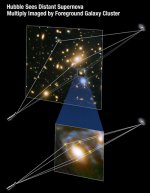Topology is a very interesting branch of mathematics.
I have been checking the Mad Professor's work, and am learning a great deal about Shapes with a Twist.
Once you have a Twist you have what we call left and right handedness.
Not many people know this, but a lot of the common molecules in Earth's organic life are handed.
Organic Vitamin C is whatever handedness you want to call it. But all plants make the same thing by some quirk of evolution. There may be planets which look much like our one, but opposite handedness. We would starve! We couldn't assimilate the food there. 😡
But when you make it inorganically in a test tube, you get a 50/50 mixture of left and right handed molecules of Vitamin C. But your body can only assimulate one of those handednesses. So you only absorb half of those 1g tablets of Vitamin C. 500mg.
So real citrus fruits are much better than Vitamin C tablets.
It seems that the other handed Vitamin C passes through us untouched and harmlessly.
This was not the case with the infamous Thalidomide morning sickness drug.
The one that passed safety tests was all one handed. A later production change created 50/50 handed drugs. These were not harmless. They caused birth defects. 😱
I have been checking the Mad Professor's work, and am learning a great deal about Shapes with a Twist.
Once you have a Twist you have what we call left and right handedness.
Not many people know this, but a lot of the common molecules in Earth's organic life are handed.
Organic Vitamin C is whatever handedness you want to call it. But all plants make the same thing by some quirk of evolution. There may be planets which look much like our one, but opposite handedness. We would starve! We couldn't assimilate the food there. 😡
But when you make it inorganically in a test tube, you get a 50/50 mixture of left and right handed molecules of Vitamin C. But your body can only assimulate one of those handednesses. So you only absorb half of those 1g tablets of Vitamin C. 500mg.
So real citrus fruits are much better than Vitamin C tablets.
It seems that the other handed Vitamin C passes through us untouched and harmlessly.
This was not the case with the infamous Thalidomide morning sickness drug.
The one that passed safety tests was all one handed. A later production change created 50/50 handed drugs. These were not harmless. They caused birth defects. 😱
Attachments
I remember discussing handedness or chirality earlier in the thread. I wish we had an index!
The left and right hands of a human are chiral. A left hand is different from a right hand in the same way a left shoe is different from a right shoe - and you wouldn't want to get your shoes mixed up would you!
Drugs that exhibit handedness are known as chiral drugs.
As you say, Steve, chiral drugs sometimes show a remarkable difference in the effect of their biological actions.
The right and left handed version of a biological compound can even have a different taste or smell. For example, the limonene found in an orange and the oppositely handed limonene found in a lemon cause the characteristically different smells due to different biochemical interactions in the human nose.
Chirality in Biochemistry
The left and right hands of a human are chiral. A left hand is different from a right hand in the same way a left shoe is different from a right shoe - and you wouldn't want to get your shoes mixed up would you!
Drugs that exhibit handedness are known as chiral drugs.
As you say, Steve, chiral drugs sometimes show a remarkable difference in the effect of their biological actions.
The right and left handed version of a biological compound can even have a different taste or smell. For example, the limonene found in an orange and the oppositely handed limonene found in a lemon cause the characteristically different smells due to different biochemical interactions in the human nose.
Chirality in Biochemistry
Much to get through here. I have some doubt as to the veracity of your quoted source, Mr. Galu:
A questionable statement IMO: Limonene - Wikipedia
AFAIK, citrus fruits are Dextro-Limonene. Pine trees smell of Laevo-Limonene. Presumably Pine nuts contain traces too. Turpentine contains a Racaemic (50/50) mixture of the two but is not recommended as a beverage due to other toxic ingredients. A mixture of Geranium and Orange oil is a delightful smell which I often buy on trips to Neal's Yard in London:
Geranium & Orange Shower Gels & Hand Washes | Neal's Yard Remedies
I am a great believer in using scented plants to keep away mosquitoes and more worrying, evil spirits. You can see a scented Geranium to the right of my newly installed (East facing) Spirit Man. Unfortunately the Lemon tree died a few winters ago. Perhaps an evil spirit. Or a late frost, which to the gardener is the same thing. It does no harm to keep other scented plants nearby. Ancient folklore says "Always keep Rosemary by your gate and Lavender by your front door". I do this too, though occasionally employ modern chemicals on greenfly. I also have an ongoing project in the secret Jurassic garden in the basement. I am not sure where that one is going, but these prehistoric ferns make excellent bathroom plants if all else fails.
Caution. Do not try growing Frankincense at home. According to the Roman historian Herodotus, Frankincense bushes are guarded by "Winged Snakes" which sound very nasty indeed. Far safer to just buy the stuff, IMO:
Frankincense & Myrrh Fragrance | Czech & Speake London
Back to Physics. You would think the Neutral Kaon was produced in Racaemic quantities in the LHC. Not so. Our Universe only likes a one-handed type. CP violation.
Kaon - Wikipedia
I believe that the other handedness is speculated to exist, but doesn't interact with normal matter via the weak interaction. It may be Dark Matter.
AZO Life Sciences said:It is known that two enantiomers of a molecule may contribute to different tastes and smells. For example, we know orange and lemon have different scents. The difference in scent is due to the presence of the (+) and (-) forms of limonene present in oranges and lemon respectively.
A questionable statement IMO: Limonene - Wikipedia
AFAIK, citrus fruits are Dextro-Limonene. Pine trees smell of Laevo-Limonene. Presumably Pine nuts contain traces too. Turpentine contains a Racaemic (50/50) mixture of the two but is not recommended as a beverage due to other toxic ingredients. A mixture of Geranium and Orange oil is a delightful smell which I often buy on trips to Neal's Yard in London:
Geranium & Orange Shower Gels & Hand Washes | Neal's Yard Remedies
I am a great believer in using scented plants to keep away mosquitoes and more worrying, evil spirits. You can see a scented Geranium to the right of my newly installed (East facing) Spirit Man. Unfortunately the Lemon tree died a few winters ago. Perhaps an evil spirit. Or a late frost, which to the gardener is the same thing. It does no harm to keep other scented plants nearby. Ancient folklore says "Always keep Rosemary by your gate and Lavender by your front door". I do this too, though occasionally employ modern chemicals on greenfly. I also have an ongoing project in the secret Jurassic garden in the basement. I am not sure where that one is going, but these prehistoric ferns make excellent bathroom plants if all else fails.
Caution. Do not try growing Frankincense at home. According to the Roman historian Herodotus, Frankincense bushes are guarded by "Winged Snakes" which sound very nasty indeed. Far safer to just buy the stuff, IMO:
Frankincense & Myrrh Fragrance | Czech & Speake London
Back to Physics. You would think the Neutral Kaon was produced in Racaemic quantities in the LHC. Not so. Our Universe only likes a one-handed type. CP violation.
Kaon - Wikipedia
I believe that the other handedness is speculated to exist, but doesn't interact with normal matter via the weak interaction. It may be Dark Matter.
Attachments
Last edited:
Actually, I first came across the "questionable statement" on Wikipedia, and not in my quoted source!I have some doubt as to the veracity of your quoted source, Mr. Galu: A questionable statement IMO: Limonene - Wikipedia
Look in the Biology section here: Chirality - Wikipedia
Interestingly, you are quoting a Wikipedia entry which you say disagrees with a Wikipedia entry.

I smell a rat! 😀
As you say, particle physics experiments seem to suggest that the universe has a preference for left-handed chirality - a preference which violates a symmetry held by the other forces of nature.Back to Physics.
I read (from Wiki!) that there may be some confusion between chirality and helicity.
The spin of a particle may be used to define a handedness or helicity for that particle. However, for massive particles, chirality is not the same as helicity.
It's all well above my pay grade. My knowledge of chiral theories is effectively non-existent!

What are chiral gauge theories? - Quora
Those Wikipedia disagreements on limonene in oranges and lemons illustrates the need to be wary of Wikipedia content, which may just be copied from another source without cross-checking.
Biological sources apparently produce only one form of the chiral molecule limonene - d limonene - which is present in both oranges and lemons.
Steve is to be congratulated on his eagle eye! 😎
Biological sources apparently produce only one form of the chiral molecule limonene - d limonene - which is present in both oranges and lemons.
Steve is to be congratulated on his eagle eye! 😎
I just came across a blurb on a super Nova recently detected. It's image has bent around a gravity sink, and appears as three images.
So is light a part of the wave function, in that it is, and is not, insofar as it is both a particle and not particle?
By that, does it both have mass and not have mass, to allow gravity to affect it sometimes? So to speak, I guess, since a photon is at the speed of light, and has no time. I guess.
So is light a part of the wave function, in that it is, and is not, insofar as it is both a particle and not particle?
By that, does it both have mass and not have mass, to allow gravity to affect it sometimes? So to speak, I guess, since a photon is at the speed of light, and has no time. I guess.
Ah! Gravitational lensing.
We don't really know what light is. As you say, it is sometimes convenient to model light as a wave and sometimes to model it as a particle.
I like to think of a photon as a 'wavicle' and leave it at that!
When it comes to "wave function", we are talking about a mathematical construct, and that's where the understanding of light gets heavy!
We don't really know what light is. As you say, it is sometimes convenient to model light as a wave and sometimes to model it as a particle.
I like to think of a photon as a 'wavicle' and leave it at that!
When it comes to "wave function", we are talking about a mathematical construct, and that's where the understanding of light gets heavy!

You are quoting an example of Strong Lensing which produces multiple images of point-like light sources such as supernovae in distant galaxies.I just came across a blurb on a super Nova recently detected. It's image has bent around a gravity sink, and appears as three images.
The explanation of the multiple images is that light can take different paths around and through a gravitational lens and hence arrive at Earth at different times.
Fun Fact: This means that new images of the supernova may be detected in a few years time! 😎
Attachments
Here's a good link to your three image supernova: Astronomers saw the Same Supernova Three Times Thanks to Gravitational Lensing. And in Twenty Years They Think They'll see it one More Time - Universe Today
I'd better answer this by saying that light has no mass.By that, does it (light) both have mass and not have mass, to allow gravity to affect it sometimes?
Light is not attracted by gravity in the way that a mass is attracted in Newton's theory.
Instead, light follows the curvature of spacetime which exists near concentrations of mass as described in Einstein's theory.
You are quoting an example of Strong Lensing which produces multiple images of point-like light sources such as supernovae in distant galaxies.
The explanation of the multiple images is that light can take different paths around and through a gravitational lens and hence arrive at Earth at different times.
Fun Fact: This means that new images of the supernova may be detected in a few years time! 😎
How does that explain gravity affecting the trajectory of something with no mass though?
Norwegian Blue?
resting photons have no mass (and no trajectory)
propagating EM waves have energy density, and therefore "relativistic mass"
giving photons mass "for gravity to act on"
resting photons have no mass (and no trajectory)
propagating EM waves have energy density, and therefore "relativistic mass"
giving photons mass "for gravity to act on"
Last edited:
If, as Newton did, you imagine that light consists of particles which have mass then you get a deflection of light that is half of Einstein's value.
However, Newton was wrong and the 'particles' of light are massless.
However, Newton was wrong and the 'particles' of light are massless.
In Newton's theory of gravity, the gravitational force only affects objects with inertial mass. Inertial mass is the resistance to acceleration given by the m in F = ma. Photons have no inertial mass as they have no resistance to acceleration, always travelling at speed c in a vacuum.
In Einstein's general relativity, matter warps spacetime. This means that objects travelling in straight lines take different paths because of the curvature of spacetime. This affects massless photons as well as matter with inertial mass.
Since photons never come to rest, they can't be considered to have rest mass.
Neither do photons have relativistic mass. Without a rest mass, the mass of a photon can’t be increased like other relativistic masses, and that's why a photon can travel at the speed of light without attaining infinite mass.
In Einstein's general relativity, matter warps spacetime. This means that objects travelling in straight lines take different paths because of the curvature of spacetime. This affects massless photons as well as matter with inertial mass.
Since photons never come to rest, they can't be considered to have rest mass.
Neither do photons have relativistic mass. Without a rest mass, the mass of a photon can’t be increased like other relativistic masses, and that's why a photon can travel at the speed of light without attaining infinite mass.
The deflection of light by gravity is calculated from the equations of general relativity. Most references shy clear of the explanation you seek as it involves th understanding of such jargon as "metric tensors" and "curvature equations".How does that explain gravity affecting the trajectory of something with no mass though?
Since curvature equations involve 10 partial differential equations, they are certainly beyond my mathematical ability to make sense of!
I found this pdf which may contain the answer you seek: https://web.mit.edu/6.055/old/S2009/notes/bending-of-light.pdf
Yes, I know! 😱The theory of general relativity formulates gravity in terms of the curvature of spacetime. Newton’s theory is the limit of general relativity that considers only time curvature; general relativity itself also calculates the space curvature.
Since most objects move much slower than the speed of light, meaning that they travel much farther in time than in space, they feel mostly the time curvature.
The Newtonian analysis is fine for those objects.
Since light moves at the speed of light, it sees equal amounts of space and time curvature, so it bends twice as far as the Newtonian theory would predict.
@ jcx and the Eddington experiment.
For many years, Einstein thought his prediction of the degree of bending of light by the Sun would simply predict the Newtonian value.
By the time of Eddington's experiment, Einstein had come up with a new theory of gravity which predicted twice the deflection.
However it wasn't until the advent of radio astronomy that Einstein's new theory of gravity was finally confirmed by accurate measurements.
Einstein's theory replaces Newton's theory when considering photons which travel at the speed of light.
For many years, Einstein thought his prediction of the degree of bending of light by the Sun would simply predict the Newtonian value.
By the time of Eddington's experiment, Einstein had come up with a new theory of gravity which predicted twice the deflection.
However it wasn't until the advent of radio astronomy that Einstein's new theory of gravity was finally confirmed by accurate measurements.
Einstein's theory replaces Newton's theory when considering photons which travel at the speed of light.
I've only ever played on the "bunny slopes" of Special Relativity, no GR education at all
happy to concede that in GR "its complicated"
maybe my use of "relativistic mass" reflects a cultural difference?
Mass in special relativity - Wikipedia
happy to concede that in GR "its complicated"
maybe my use of "relativistic mass" reflects a cultural difference?
Mass in special relativity - Wikipedia
The term "relativistic mass" tends not to be used in particle and nuclear physics and is often avoided by writers on special relativity, in favor of referring to the body's relativistic energy.[1] In contrast, "invariant mass" is usually preferred over rest energy. The measurable inertia and the warping of spacetime by a body in a given frame of reference is determined by its relativistic mass, not merely its invariant mass. For example, photons have zero rest mass but contribute to the inertia (and weight in a gravitational field) of any system containing them.
- Status
- Not open for further replies.
- Home
- Member Areas
- The Lounge
- What is the Universe expanding into..






